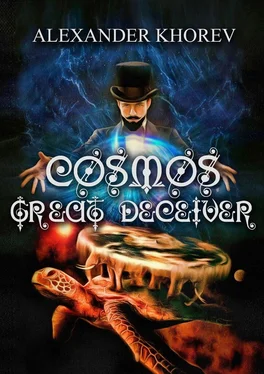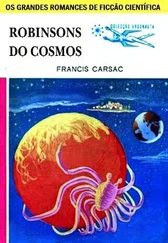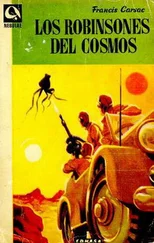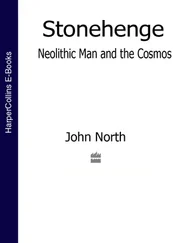Aleksandr Khorev - Cosmos – Great Deceiver
Здесь есть возможность читать онлайн «Aleksandr Khorev - Cosmos – Great Deceiver» — ознакомительный отрывок электронной книги совершенно бесплатно, а после прочтения отрывка купить полную версию. В некоторых случаях можно слушать аудио, скачать через торрент в формате fb2 и присутствует краткое содержание. ISBN: , Жанр: Прочая научная литература, на английском языке. Описание произведения, (предисловие) а так же отзывы посетителей доступны на портале библиотеки ЛибКат.
- Название:Cosmos – Great Deceiver
- Автор:
- Жанр:
- Год:неизвестен
- ISBN:9788381898829
- Рейтинг книги:5 / 5. Голосов: 1
-
Избранное:Добавить в избранное
- Отзывы:
-
Ваша оценка:
- 100
- 1
- 2
- 3
- 4
- 5
Cosmos – Great Deceiver: краткое содержание, описание и аннотация
Предлагаем к чтению аннотацию, описание, краткое содержание или предисловие (зависит от того, что написал сам автор книги «Cosmos – Great Deceiver»). Если вы не нашли необходимую информацию о книге — напишите в комментариях, мы постараемся отыскать её.
Cosmos – Great Deceiver — читать онлайн ознакомительный отрывок
Ниже представлен текст книги, разбитый по страницам. Система сохранения места последней прочитанной страницы, позволяет с удобством читать онлайн бесплатно книгу «Cosmos – Great Deceiver», без необходимости каждый раз заново искать на чём Вы остановились. Поставьте закладку, и сможете в любой момент перейти на страницу, на которой закончили чтение.
Интервал:
Закладка:
With some things, I more or less figured out, in any case, I was able to isolate and mark the individual details of the space device. But still, as I went deeper into the cosmic problems, I didn’t leave the feeling that I didn’t grasp the overall picture that made up these details. There is only a feeling that this picture is very peculiar. It is fundamentally different from the understanding of the cosmos, not only ordinary people, but also scientists.
Well, now, it seems, I said everything.
Chapter 1. Length, width, height
Let’s start with simple things – the usual spatial dimensions: length, width and height. On the graph, these are the so-called Cartesian coordinates, the x, y, and z axes.

These are straight lines, which is very pleasing. But the joy ends there. It is alarming that all three dimensions do not exist by themselves, but come from a single point. For some reason, this point is called zero by mathematicians. Although from my point of view, zero is nothing. It turns out that these three lines come out of nothing. Imagine now that in your room “nothing” is hiding in a corner, and in every corner. How many corners so many “nothing” and all this calls “nothing”. If we are to be honest to the end, then zero must be designated so that these three lines did not connect. The zero must be really empty. If these lines were terminated without reaching the connection point, this would really be zero. And so, all sorts of speculations begin. For example,
What is a vacuum – is it really emptiness, zero, or is it something incomprehensible to us, some mysterious form of matter?
The next alarming moment from the “nothing” lines come out at right angles to each other. You can take the paper and draw countless straight lines coming from one point. But the paradox is that at right angles only three lines can be drawn: length, width and height. What is a good angle? It is as if neutral: neither ours nor yours. Of course, straight lines can be extended beyond “nothing”, also with right angles. They will be like an inverted reflection of straight lines to “nothing”, but your neighbors may already live there and therefore, among mathematicians, these three lines after zero come with a minus sign. Or maybe you have no neighbors, then there is another world hiding behind “nothing” – maybe anti-world and antimatter. You live in the right “positive” world
And who lives in a “negative” world?
The question about the negative zone of the graph is better formulated differently. The plus zone of the graph corresponds to our three-dimensional physical world.
But can the minus zone also correspond to the existence of some kind of reality, separated from ours?
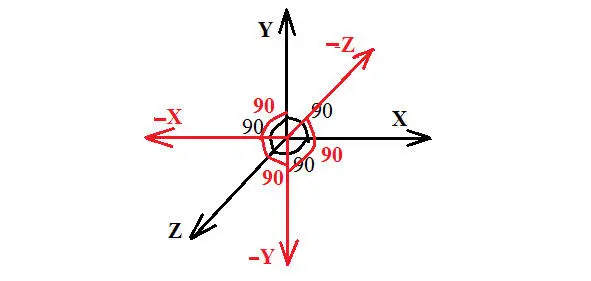
And one more nuance: you put a ruler, and it lies, lies to itself, does not touch anyone, and those three lines come out of this “nothing”. They do not lie near the “nothing” they just go out. There is already an element of movement. To show this, sometimes at the end of these lines draw arrows and call them vectors. In general, unusual things begin literally from the first step. Now listen further. I was once again surprised. What are these straight lines themselves? Here’s the mathematical definition of a line: “A line is a collection of points”. Yes, yes! It is a collection of points! It turns out that the line is not something that lasts for some distance, but the points arranged in a row. Lines, it turns out not, but there are only points. Again points, again “nothing.”
Let’s talk about the point. Although it is denoted by zero on Cartesian coordinates. The point is really zero, really nothing, the complete absence of space, namely: length, width and height. But it is necessary to somehow denote zero, and mathematicians conditionally designated it with a dot. But in reality, all three lines rest on zero, rest in the absence of space. But what is interesting, although it is zero and nothing, it plays a prominent role in the dimensional Universe, at least for contrast. Here is a dimensional Universe with a length, width and height, that is, space. And there is a zero without length, width and height, that is, the absence of space. We will often return to zero as a no-space indication. Zero is present everywhere. He is like a beginning. There is zero – the absence of space, and immediately after it the space begins: length, width and height. And I would say that, really, as in Cartesian coordinates, zero is an inseparable element of space, this is the beginning, this is the point of reference. And, I repeat, in the future we will always rely on this beginning. I came to the conclusion that zero is really the cornerstone of our universe.
I will say right away: before the start of my investigation, I did not know this. Therefore, when I began to study textbooks, and analyze what I read, each new page brought me new discoveries. I wanted to put everything in its place, but from the very first steps it became clear that in order to put everything in its place or put everything on the shelves, it would be necessary to prepare a new room, and the shelves should be of a different kind. Too unusual opened a new world. And yet, I wanted to understand him, and understand everything.
It is considered that our space is three-dimensional. It has a length, width and height or in other words: line, area and volume. A point is literally the source, the beginning of three-dimensional space. But while I will not be distracted, thinking about this issue. Continue to deal with the length, width and height. When popular literature describes the properties of three-dimensional space, it also tells you how the two-dimensional and one-dimensional worlds would look like, and how the inhabitants of these worlds would perceive various physical phenomena (unfortunate inhabitants!). It is believed that our three-dimensional world has volume. Accordingly, the two-dimensional world is a plane, and one-dimensional – a line. And again we slipped to the point. The point has no measurements.
And the world concluded at the point?..
And now mentally we will increase the dimensionless point to the size of the ball and see how it fits into the spatial dimensions. In our three-dimensional space, the ball has volume. If this ball intersected the plane of the two-dimensional world, then the inhabitants of this world would first see a point that would increase in size (a sort of Big Bang of the two-dimensional world) and turn into an increasing circle. Of course, the scientists of this two-dimensional world would begin to guess whether the expansion, about which the “redshift” of their space speaks, will always continue, or the mass of the circle will be large enough, and eventually it will shrink. Meanwhile, the ball crossed the equator and the two-dimensional inhabitants saw that it shrinks and turns into a point again, and finally, it completely disappeared. In this regard, let us ask this question:
Was there really “Big Bang”?. .
We will return to the problem of the intersection of a plane with a ball and the ball itself, and at the same time a circle. For now, let’s return to the description of two-dimensional and one-dimensional spaces. The hypothetical inhabitants of the two-dimensional world will perceive the ball as a circle. And if their flat world will cross another plane, they will perceive it as a line. Accordingly, in one-dimensional space the ball will be perceived as a line, and the line as a point. We now know how the inhabitants of two-dimensional and one-dimensional spaces would perceive the ball and the plane crossing their limited worlds. And now we call these residents observers. The observer is always outside the observed object, even if it is physically located inside the object, for example, the same ball or examines its insides through a microscope. The observer is different from the observed object. A clear boundary separates him from the observed object, otherwise he simply could not separate himself from what he observes. Since the observer can see with his eyes (in the extreme case, he perceives with the senses), the observed object must be in front of the eyes – outside the observer. I agree that the inhabitants of the flat world would perceive the ball as a circle … to the touch, but they would only see a line – a sizeable segment. It is we, the inhabitants of the three-dimensional world, who see that they are dealing with a circle. And now we ask ourselves: what do the inhabitants of the one-dimensional world see when their line crosses the ball? If they are on both sides of the ball, then they tell each other that some kind of a segment extends, and then a shortening segment obstructs their path, but each of them would see only a point. That is, they both see one dimension less than the space where they live. Then ask yourself this question:
Читать дальшеИнтервал:
Закладка:
Похожие книги на «Cosmos – Great Deceiver»
Представляем Вашему вниманию похожие книги на «Cosmos – Great Deceiver» списком для выбора. Мы отобрали схожую по названию и смыслу литературу в надежде предоставить читателям больше вариантов отыскать новые, интересные, ещё непрочитанные произведения.
Обсуждение, отзывы о книге «Cosmos – Great Deceiver» и просто собственные мнения читателей. Оставьте ваши комментарии, напишите, что Вы думаете о произведении, его смысле или главных героях. Укажите что конкретно понравилось, а что нет, и почему Вы так считаете.
